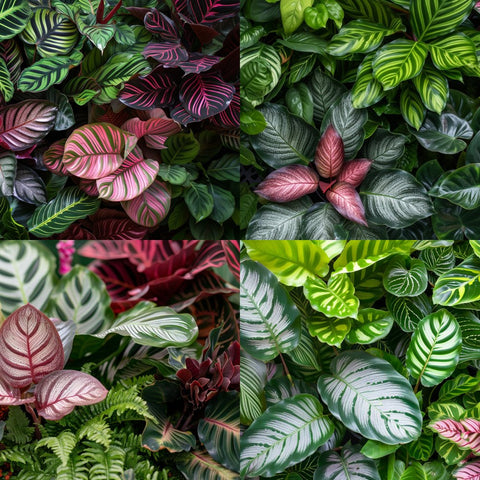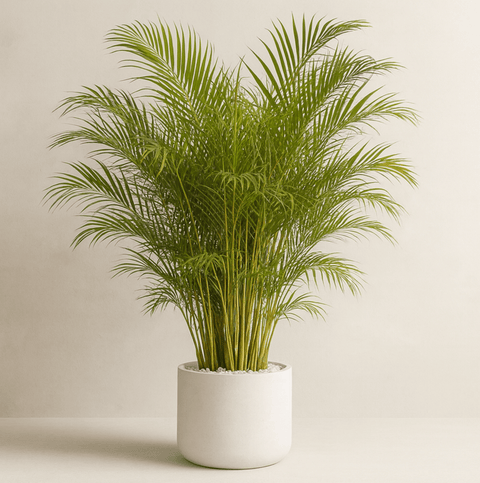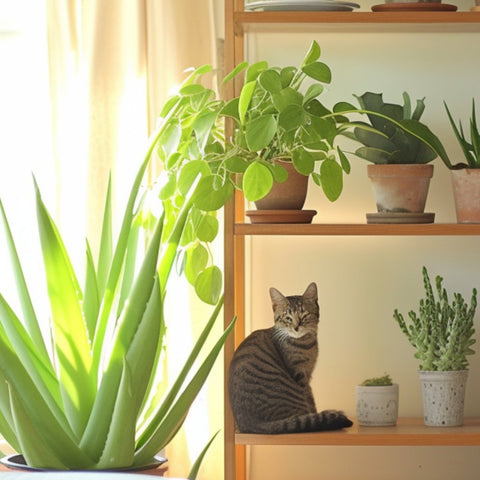Blog Post - Calathea
Calathea: A Unique and Popular Houseplant
Are you looking to add a touch of elegance and vibrancy to your indoor space? Look no further than the calathea, a stunning houseplant with a distinct personality. In this article, we will introduce you to the world of calathea, explore its different varieties, provide care tips and propagation techniques, and even share some design ideas for incorporating calathea into your home décor. So, let's dive in and discover the wonders of calathea!
I. Introduction to Calathea

A. Explanation of what calathea is
Calathea is a genus of flowering plants native to the tropical regions of Central and South America. It is a member of the Marantaceae family, which includes other popular houseplants like the prayer plant (Maranta), the stromanthe, and the ctenanthe. Calathea plants are prized for their stunning foliage, which comes in a range of colors, patterns, and shapes. With their large, decorative leaves and intricate patterns, calathea plants are often referred to as "living works of art."
B. Overview of its popularity and unique characteristics
Calathea has gained immense popularity among indoor plant enthusiasts for its unique characteristics. One of the most striking features of calathea is its ability to "prayer" its leaves. During daylight hours, the leaves of many calathea varieties are upright and open, showcasing their intricate patterns. However, as the evening approaches, they fold their leaves together, resembling praying hands. This daily ritual has earned them the nickname "prayer plants."
In addition to their captivating movements, calathea plants are known for their ability to purify the air. Like many other houseplants, they actively remove toxins from the air, improving the overall air quality in your home.
II. The Different Varieties of Calathea
Calathea plants come in a wide range of varieties, each with its own unique characteristics and charm. Here are some of the most popular calathea varieties:
1. Calathea orbifolia

Calathea orbifolia is known for its large, round leaves that feature silver-gray stripes and dark green borders. Its striking foliage adds a touch of elegance to any room. This variety requires bright, indirect light and moderate humidity to thrive.
2. Calathea Medallion

Calathea medallion is named after its bold, round leaves that resemble medallions. The leaves are deep green with intricate patterns of white or pink-colored veins. This variety is relatively low-maintenance and can tolerate lower light conditions compared to other calathea varieties.
3. Calathea Lancifolia (Rattlesnake plant)

Calathea lancifolia, also known as the rattlesnake plant, features long, lance-shaped leaves with dark green stripes and a deep purple underside. The patterns on its leaves resemble the intricate skin of a rattlesnake. This variety is relatively forgiving and can tolerate slightly lower humidity levels.
4. Calathea roseopicta (Rose painted calathea)

Calathea roseopicta, commonly known as the rose painted calathea, showcases stunning foliage with dark green leaves and vibrant pink stripes. The patterns on its leaves resemble brushstrokes of a delicate rose painting. This variety requires bright, indirect light and high humidity to thrive.
III. How to Care for Calathea
To ensure your calathea plants thrive and showcase their full beauty, proper care is essential. Here are some guidelines to help you care for your calathea plants:
A. Light requirements for calathea plants
Calathea plants prefer bright, indirect light. Direct sunlight can scorch their leaves, so it is best to place them near a north or east-facing window where they can receive filtered sunlight. If your calathea is not getting enough light, its leaves may lose their vibrant colors and patterns.
B. Temperature and humidity needs
Calathea plants thrive in moderate temperatures ranging from 65°F to 80°F (18°C to 27°C). They prefer high humidity levels, so it is important to create a humid environment for them. You can achieve this by using a humidifier, placing your calathea near a pebble tray filled with water, or misting its leaves regularly.
C. Watering and soil requirements
Calathea plants prefer consistently moist soil but do not tolerate sitting in water. Allow the top inch of soil to dry out before watering your calathea. It is important to use well-draining soil to prevent waterlogged conditions that can lead to root rot.
D. Fertilizing tips for calathea
During the growing season, from spring to summer, you can fertilize your calathea once a month using a balanced houseplant fertilizer. Dilute the fertilizer to half strength and apply it to moist soil. Avoid fertilizing during the winter months when the plant is in a period of dormancy.
E. Pests and common problems with calathea
Calathea plants are generally resilient, but they can be susceptible to some pests, including spider mites and mealybugs. Regularly inspect your plants for any signs of pests, and if necessary, treat them with organic pest control methods like neem oil or insecticidal soap.
IV. Propagation Techniques for Calathea
If you wish to expand your collection of calathea plants or share them with friends and family, propagation is the way to go. Here are two common methods of propagating calathea plants:
1. Dividing the plant
Dividing a mature calathea plant is one way to propagate it. Gently remove the plant from its pot and carefully divide the root ball into smaller sections, making sure each section has healthy roots and foliage. Plant each division in its own pot with well-draining soil, and provide the same care as you would for a mature plant.
2. Leaf cuttings
Another method of propagating calathea is through leaf cuttings. Select a healthy leaf from the mother plant and cut it into smaller sections, ensuring each section has a vein attached. Place the leaf cuttings in a container with water or moist soil, and provide them with bright, indirect light. Within a few weeks, the leaf cuttings should start developing roots and can be planted in individual pots.
V. Design Ideas: Using Calathea in Home Décor
Calathea plants not only bring natural beauty to your home, but they can also enhance your interior design. Here are some design ideas for incorporating calathea into your home décor:
1. Use calathea as a focal point in a room
With their large, eye-catching leaves, calathea plants can take center stage in any room. Place them on a side table, on a plant stand, or in a decorative pot, and let their distinctive foliage become the focal point of the space.
2. Combine calathea with other houseplants for a lush look
Create a lush and vibrant display by combining calathea with other houseplants. Mix different varieties of calatheas with plants of varying shapes, sizes, and textures to create an indoor jungle that brings life and energy to your space.
3. Incorporate calathea in terrariums or hanging planters
Calathea plants can also thrive in terrariums or hanging planters, adding visual interest at different levels in your home. These unique planters allow you to create a mini indoor garden and showcase the intricate patterns of calathea leaves in a captivating way.
VI. Common Questions and Answers about Calathea
A. Addressing frequently asked questions about calathea care
-
Can calathea tolerate low light conditions? While calatheas prefer bright, indirect light, some varieties can tolerate lower light conditions. However, be careful not to place them in deep shade, as this can cause their colors to fade and impact their overall health.
-
How often should I water my calathea? Calathea plants prefer consistently moist soil. Water your calathea when the top inch of soil feels dry, but avoid overwatering, as it can lead to root rot.
-
What causes calathea leaves to curl or brown? Curling or browning leaves in calathea plants can indicate various issues, including underwatering, low humidity, or exposure to cold drafts. Make sure you are providing the right conditions for your calathea and adjust care accordingly.
-
Can calathea be grown outdoors? While calathea plants are primarily grown as indoor houseplants, some varieties can be grown outdoors in tropical and subtropical regions. However, they require consistent warmth, high humidity, and protection from direct sunlight and harsh weather conditions.
VII. Conclusion
In conclusion, calathea plants offer a unique blend of elegance and vibrancy that can breathe new life into your indoor space. Whether you are a novice plant parent or an experienced green thumb, incorporating calathea into your plant collection is sure to bring joy and beauty to your home. From their distinctive foliage and air-purifying qualities to their relatively low-maintenance care requirements, calathea plants are a delightful addition to any space. So, why wait? Start exploring the world of calathea and enjoy the wonders it has to offer!






















Comments (0)
There are no comments for this article. Be the first one to leave a message!